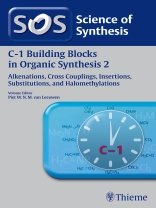The two-volume set on C-1 Building Blocks in Organic Synthesis critically reviews the state of the art of a wide variety of reactions by which one carbon atom is added to an organic molecule, forming a C-C bond. In spite of the numerous classic reactions of this kind, there has been enormous progress in recent years, especially for those reactions involving catalytic methods. Introduction of substituted methyl groups is a major challenge and only very recently the first catalysts have been discovered that enable the introduction of fluoromethyl groups in aromatics.
Inhoudsopgave
2.1 C-1 Alkenation
2.1.1 Modern Variants of Wittig, Peterson, and Tebbe Protocols
2.2 C—C Cross Coupling
2.2.1 Cross-Coupling Methods for Methylation
2.2.2 Carbonylation of Aryl and Vinyl Halides
2.2.3 Cyanation of Aryl Halides
2.2.4 Oxidative Coupling of Nitromethane
2.3 Insertion into C—H Bonds
2.3.1 Carbene Insertion into C—H Bonds with C-1
2.4 Insertion into C—O and C—N Bonds
2.4.1 Carbon Monoxide Insertion into Epoxides and Oxetanes
2.4.2 Carbon Monoxide Insertion into Aziridines
2.5 Substitution Reactions
2.5.1 Hydroformylation of Epoxides
2.5.2 Cyanation of Epoxides
2.5.3 Cyanation of Aziridines
2.5.4 Carboxylation of Organometallic Reagents
2.5.5 Reaction of Formaldehyde with Organometallic Reagents
2.5.6 Mannich-Type Reactions
2.5.7 Formylation and the Vilsmeier Reagent
2.5.8 Metathesis Adding a C-1 Unit
2.6 Halomethylation
2.6.1 Trifluoromethylation
2.6.2 Difluoro- and Fluoromethylation
2.6.3 Karasch Reaction (Atom-Transfer Radical Addition Reactions)












